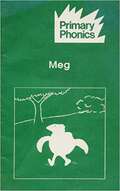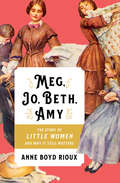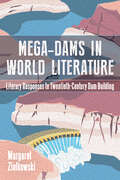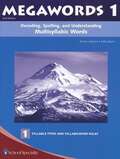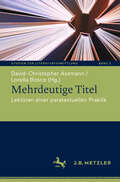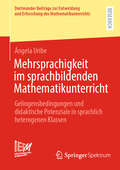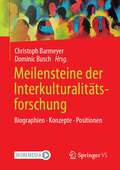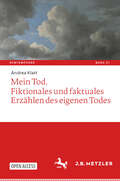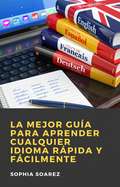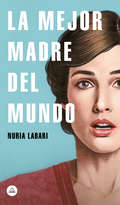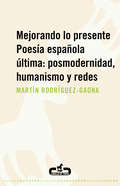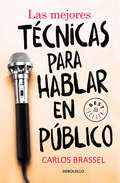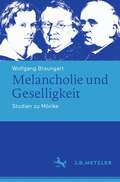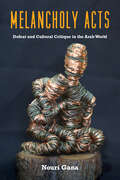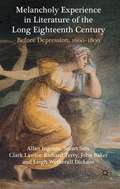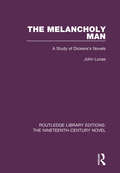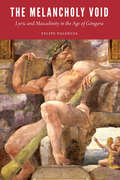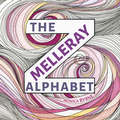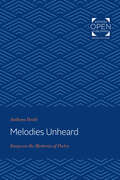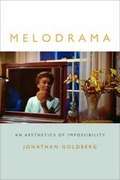- Table View
- List View
Meg, Jo, Beth, Amy: The Story Of Little Women And Why It Still Matters
by Anne Boyd RiouxOn its 150th anniversary, discover the story of the beloved classic that has captured the imaginations of generations. Soon after publication on September 30, 1868, Little Women became an enormous bestseller and one of America’s favorite novels. Its popularity quickly spread throughout the world, and the book has become an international classic. When Anne Boyd Rioux read the novel in her twenties, she had a powerful reaction to the story. Through teaching the book, she has seen the same effect on many others. In Meg, Jo, Beth, Amy, Rioux recounts how Louisa May Alcott came to write Little Women, drawing inspiration for it from her own life. Rioux also examines why this tale of family and community ties, set while the Civil War tore America apart, has resonated through later wars, the Depression, and times of changing opportunities for women. Alcott’s novel has moved generations of women, many of them writers: Simone de Beauvoir, J. K. Rowling, bell hooks, Cynthia Ozick, Jane Smiley, Margo Jefferson, and Ursula K. Le Guin were inspired by Little Women, particularly its portrait of the iconoclastic young writer, Jo. Many have felt, as Anna Quindlen has declared, “Little Women changed my life.” Today, Rioux sees the novel’s beating heart in Alcott’s portrayal of family resilience and her honest look at the struggles of girls growing into women. In gauging its current status, Rioux shows why Little Women remains a book with such power that people carry its characters and spirit throughout their lives.
Mega-Dams in World Literature: Literary Responses to Twentieth-Century Dam Building
by Margaret ZiolkowskiMega-Dams in World Literature reveals the varied effects of large dams on people and their environments as expressed in literary works, focusing on the shifting attitudes toward large dams that emerged over the course of the twentieth century. Margaret Ziolkowski covers the enthusiasm for large-dam construction that took place during the mid-twentieth-century heyday of mega-dams, the increasing number of people displaced by dams, the troubling environmental effects they incur, and the types of destruction and protest to which they may be subject. Using North American, Native American, Russian, Egyptian, Indian, and Chinese novels and poems, Ziolkowski explores the supposed progress that these structures bring. The book asks how the human urge to exploit and control waterways has affected our relationships to nature and the environment and argues that the high modernism of the twentieth century, along with its preoccupation with development, casts the hydroelectric dam as a central symbol of domination over nature and the power of the nation state. Beyond examining the exultation of large dams as symbols of progress, Mega-Dams in World Literature takes a broad international and cultural approach that humanizes and personalizes the major issues associated with large dams through nuanced analyses, paying particular attention to issues engendered by high modernism and settler colonialism. Both general and specialist readers interested in human-environment relationships will enjoy this prescient book.
Megawords 1: Decoding, Spelling, and Understanding Multisyllabic Words, Syllable Types and Syllabication Rules
by Kristin Johnson Polly BayrdNIMAC-sourced textbook
Megawords 2: Decoding, Spelling, and Understanding Multisyllabic Words, Common Prefixes and Suffixes
by Kristin Johnson Polly BayrdNIMAC-sourced textbook
Megawords 3: Decoding, Spelling, and Understanding Multisyllabic Words, Schwa Sound
by Kristin Johnson Polly BayrdNIMAC-sourced textbook
Megawords 4: Decoding, Spelling, and Understanding Multisyllabic Words, Advanced Suffixes
by Kristin Johnson Polly BayrdNIMAC-sourced textbook
Mehrdeutige Titel: Lektüren einer paratextuellen Praktik (Studien zur Literaturvermittlung #2)
by David-Christopher Assmann Lorella BoscoGérard Genette zufolge ist die literaturtheoretische Bestimmung des Titels „problematischer als bei den anderen Elementen des Paratextes“. Der Band setzt an dieser Beobachtung an und macht sie für die Untersuchung literarischer Mehrdeutigkeit produktiv. Die Beiträge gehen der Frage nach, inwiefern Titel an peritextuellen Praktiken der Erzeugung, Rezeption und Vermittlung literarischer Mehrdeutigkeit beteiligt sind. Im Zentrum stehen mehrdeutige oder auffallend eindeutige Titel seit dem 18. Jahrhundert bis in die Gegenwart: kurze oder lange Titel, semantisch leere, selbstreferentielle oder bemerkenswert intertextuelle Titel, einprägsame oder doppeldeutige Titel, besonders prägnante oder fehlende Titel.
Mehrsprachigkeit im sprachbildenden Mathematikunterricht: Gelingensbedingungen und didaktische Potenziale in sprachlich heterogenen Klassen (Dortmunder Beiträge zur Entwicklung und Erforschung des Mathematikunterrichts #53)
by Ángela UribeIn einem verstehensorientierten sprachbildenden Mathematikunterricht wird Sprache als Denkwerkzeug und somit als Schlüssel zum konzeptuellen Verständnis verstanden. Vor diesem Hintergrund stellt sich die Frage nach der Rolle anderer Sprachen neben der Unterrichtssprache im Lehr-Lern-Prozess. Insbesondere in einer mehrsprachigen Gesellschaft – wie Deutschland – treffen im Unterricht diverse Sprachen aufeinander und die Lernenden bringen eine Vielzahl von Ressourcen als Teil ihrer sprachlichen Repertoires mit, die über die Unterrichtssprache hinausgehen. Diese mehrsprachigen Repertoires der Lernenden können gerade für die Bedeutungskonstruktion beim Aufbau von konzeptuellem Verständnis eine wertvolle Ressource darstellen. Das vorliegende Buch trägt dazu bei, den Einbezug dieser vielfältigen Repertoires im Mathematikunterricht in sprachlich heterogenen Regelklassen zu konkretisieren. Es bietet dabei sowohl unmittelbare Ansatzpunkte für die Praxis als auch eine solide Grundlage für zukünftige Untersuchungen, die darauf abzielen, den Mathematikunterricht in einer zunehmend mehrsprachigen Welt weiter zu verstehen und zu verbessern. Das Buch markiert einen bedeutenden Schritt vorwärts im Einbezug von Mehrsprachigkeit als Ressource im Mathematikunterricht und setzt damit ein starkes Signal für eine inklusive und weltoffene Didaktik.
Meilensteine der Interkulturalitätsforschung: Biographien. Konzepte. Positionen
by Christoph Barmeyer Dominic BuschInterkulturalität betrifft den gegenseitigen Verständigungsprozess von Personen, die verschiedenen Kulturen zugehörig sind und insofern nicht über dieselben Wertorientierungen, Bedeutungssysteme und Wissensbestände verfügen. Interkulturalität betrifft in jüngster Zeit immer mehr Menschen, sei es außerhalb oder innerhalb der eigenen Lebenswelten. Im Rahmen interkultureller Kontakte erfahren Personen nicht nur Ähnlichkeiten und Gemeinsamkeiten, sondern auch Unterschiede und Irritationen, die verstanden werden wollen. Aus diesem Grund hat die Forschung und Praxis zur Interkulturellen Kommunikation in den letzten Jahrzehnten – ausgehend von den USA – weltweit zunehmende Bedeutung und dynamische Entwicklung erfahren.Dieser Sammelband bietet einen innovativen und originellen Zugang zur Interkulturalitätsforschung: Im Mittelpunkt stehen für die Forschung bedeutende Personen, „Interkulturalisten“, die zentrale Theorien, Modelle und Konzepte erarbeitet und somit das Fach maßgebend geprägt haben. Es werden Zusammenhänge zwischen Interkulturalisten und bestimmten Themen, Theorien, Wissenschaftsdisziplinen und „Schulen“ hergestellt. Ebenso wird gezeigt, wie diese konzeptuellen Bezugsrahmen nutzbar sind, um die „interkulturelle Wirklichkeit“ besser zu verstehen.
Mein Tod. Fiktionales und faktuales Erzählen des eigenen Todes (Kontemporär. Schriften zur deutschsprachigen Gegenwartsliteratur #21)
by Andrea KlattDies ist ein Buch im Open Access. - Der eigene Tod ist nicht zu bewältigen. Die Textsorte ‚Erzählung‘ ermöglicht aufgrund ihrer Eigenschaften jedoch die Bewältigung von Erfahrungen, die dem Tod ähneln sollen. Fiktionalem und faktualem Erzählen kommen dabei qua literarischer Konvention unterschiedliche Möglichkeiten zu. Anhand zahlreicher Beispiele von Sterbeerzählungen von 1950 bis heute legt Andrea Klatt eine Systematik der Formen und Funktionen des Erzählens in Todesnähe vor. Außerdem werden drei Erzähltexte der deutschsprachigen Gegenwartsliteratur in ausführlichen Fallstudien interpretiert und die unterschiedlichen Bewältigungsmechanismen darin verglichen: „Arbeit und Struktur“ von Wolfgang Herrndorf, „Tage wie Hunde“ von Ruth Schweikert und „Robinsons blaues Haus“ von Ernst Augustin.
La Mejor Guía para Aprender Cualquier Idioma Rápida y Fácilmente
by Sophia SoarezUna guía detallada para aprender un idioma de una forma fácil y rápida. Esta guía te ayudará a aprender un nuevo idioma en una semana. Te enseñará tips para convertirte en un hablante nativo. Basado en hechos científicos este libro te instruirá en: La forma más fácil para aprender un nuevo idioma Aprovechar el tiempo de una forma efectiva Convertirte en un hablante nativo Aprender pronunciaciones correctamente Posicionar la boca para la correcta pronunciación Mantenerse motivado Mejorar el acento Si quieres aprender un nuevo idioma en una semana y así convertirte en hablante nativo, entonces este post es para tí. ---Desplaza hasta arriba de la página y clickea ¨Añadir al carrito¨ para comprar instantáneamente.--- Descargo: Este autor y/o titular de derechos no hace reclamos, promesas o garantías sobre la exactitud, integridad o adecuación de los contenidos de este libro y expresamente renuncia a la responsabilidad por errores y omisiones en los contenidos dentro de ellos. Este producto es solo para referencia.
La mejor madre del mundo
by Nuria LabariUna novela rompedora que disecciona el mito de la maternidad desde una nueva perspectiva y que enriquece el debate sobre la ambivalencia que genera esta experiencia en la identidad femenina contemporánea. «Prepárate para leer un libro como nunca has leído antes, que rompe las convenciones de lo narrativo y lo biográfico, de los valores no sólo tradicionales, sino también de los alternativos. Un libro de humor, de amor y de dolor, tan embriagante como un vino fuerte y tan tumultuoso como la vida. A decir verdad, no concibo que pueda haber alguien a quien no le guste.» Rosa Montero La protagonista de esta novela tiene treinta y cinco años y es estéril cuando la Idea de ser madre se le mete en el cuerpo "como un cáncer". Cinco años y dos hijas después cree haberlo ganado y perdido todo. Es entonces cuando decide escribir una historia a vida o muerte, un duelo entre la escritoraque fue y la madre en que se ha convertido. Si gana la madre, el libro será un diario sobre su maternidad y una parte de la escritora morirá en el intento. Si gana la escritora, la ficción le arrebatará su propia historia al elevar su maternidad a lo universal. En ese caso, será la escritora quien fulmine a la madre. El resultado es un relato apabullante y siempre ambivalente sobre una experiencia definitiva donde humor, amor y horror se convierten en hilos de la misma trenza. La protagonista examina el mito (pero también el timo) de la maternidad, dialogando abiertamente con todas las voces del pasado que de una manera u otra han alimentado su condición de mujer (y en consecuencia de madre): desde la legendaria homínida Lucy, "madre de la humanidad" hasta la Cenicienta, pasando por Platón, Teresa de Jesús, Darwin, Maupassant o Simone de Beauvoir. En esta novela donde convergen la ficción, la autobiografía y el ensayo, la protagonista trata su propia y palpitante maternidad como un cadáver al que disecciona en directo ante el inevitable estupor del lector. Una invitación abierta a todos los hombres y mujeres que se atrevan a entrar en la mente y el cuerpo de una madre. «Hay muchas maneras de hablar de la maternidad, pero la de Nuria Labari es profundamente original y brillante. Esta novela es una explosión, un viaje intelectual a través de los instintos más primarios y del amor más humano. Nuria Labari ha escrito un libro necesario sobre un tema universal.» Lara Moreno De su anterior novela, Cosas que brillan cuando están rotas, se ha dicho:«Una historia contada en el filo de la navaja, una crónica novelada que indaga en el dolor y en la maldad, pero también en el amor, la solidaridad y la esperanza.»TodoLiteratura «Con una escritura limpia, veloz y punzante, que se mete en el alma del lector desde el principio, la novela de Labari deja un poso para la reflexión sobre el dolor y un espacio para comprender y socorrer al individuo frágil y contingente en medio de la sociedad de hoy.»El Confidencial
La mejor madre del mundo
by Nuria LabariUna novela rompedora que disecciona el mito de la maternidad desde una nueva perspectiva y que enriquece el debate sobre la ambivalencia que genera esta experiencia en la identidad femenina contemporánea. «Prepárate para leer un libro como nunca has leído antes, que rompe las convenciones de lo narrativo y lo biográfico, de los valores no sólo tradicionales, sino también de los alternativos. Un libro de humor, de amor y de dolor, tan embriagante como un vino fuerte y tan tumultuoso como la vida. A decir verdad, no concibo que pueda haber alguien a quien no le guste.» Rosa Montero La protagonista de esta novela tiene treinta y cinco años y es estéril cuando la Idea de ser madre se le mete en el cuerpo "como un cáncer". Cinco años y dos hijas después cree haberlo ganado y perdido todo. Es entonces cuando decide escribir una historia a vida o muerte, un duelo entre la escritoraque fue y la madre en que se ha convertido. Si gana la madre, el libro será un diario sobre su maternidad y una parte de la escritora morirá en el intento. Si gana la escritora, la ficción le arrebatará su propia historia al elevar su maternidad a lo universal. En ese caso, será la escritora quien fulmine a la madre. El resultado es un relato apabullante y siempre ambivalente sobre una experiencia definitiva donde humor, amor y horror se convierten en hilos de la misma trenza. La protagonista examina el mito (pero también el timo) de la maternidad, dialogando abiertamente con todas las voces del pasado que de una manera u otra han alimentado su condición de mujer (y en consecuencia de madre): desde la legendaria homínida Lucy, "madre de la humanidad" hasta la Cenicienta, pasando por Platón, Teresa de Jesús, Darwin, Maupassant o Simone de Beauvoir. En esta novela donde convergen la ficción, la autobiografía y el ensayo, la protagonista trata su propia y palpitante maternidad como un cadáver al que disecciona en directo ante el inevitable estupor del lector. Una invitación abierta a todos los hombres y mujeres que se atrevan a entrar en la mente y el cuerpo de una madre. «Hay muchas maneras de hablar de la maternidad, pero la de Nuria Labari es profundamente original y brillante. Esta novela es una explosión, un viaje intelectual a través de los instintos más primarios y del amor más humano. Nuria Labari ha escrito un libro necesario sobre un tema universal.» Lara Moreno Críticas:«No sé quién será la mejor madre del mundo, pero Nuria Labari sabe ser luz y conquistar almas en 224 páginas. Y eso no lo consigue todo el mundo.»Marta Hernández, Blog El club de malas madres «La mejor madre del mundo es un misil de crucero capaz de dar en todas las dianas, de callar todas las bocas y rearmarlas con el poder absoluto de la lucidez. Es la demostración de que en todas las tormentas hay al menos un rayo que encuentra su lugar.»Sonia Fides, El asombrario «Este es solo su segundo libro y uno de los favoritos de la crítica.»Loreto Sánchez Seoane, El Independiente «Esta novela se une al debate que ya abrieron personajes públicos como Samanta Villar: la ambivalencia que genera la maternidad en la identidad femenina contemporánea.»Anabel Palomares, Trendencias «Esta crónica sincera y visceral de la maternidad no se calla nada.»Martín Piñol, El País «Para Labari lo importante es "sacar el tema de la maternidad a la calle y a los libros, para restar ese deber ser maternal que nos inunda y que se cuela hasta en nuestra manera de vivir el sexo.»Paola Aragón, Fashion&arts «El libro de Nuria Labari hay que leerlo despacito, con un lápiz, subrayando. Y, al acabar cada capítulo, levantarse, pasear, pensar. Es un libro necesario y, a la vez, insuficie
Mejorando lo presente. Poesía española última: Poesía española última: posmodernidad, humanismo y redes
by Martín Rodríguez-GaonaUn polémico ensayo sobre la poesía española más viva, dinámica y actual, esa que nace de un movimiento poético multiforme y desprovisto de plataforma, formado por un grupo numeroso de autores y autoras que irrumpe en la escena literaria con obras renovadoras, de inusual energía y calidad, en un tiempo donde la literatura comercial parecía imponerse completamente. Aviso de lectura Pues si Paul Éluard dijo aquello tan sabio y rotundo de «La poesía es algo absolutamente necesario aunque me gustaría saber para qué», imagínense lo que diría de un ensayo sobre poesía: «Este libro es absolutamente innecesario y por tanto polémico, inevitable, posmoderno y personal». Si la poesía, Homero dixit, es un virus troyano programado para alterar el disco duro de la imaginación colectiva y un poeta es un explorador o un señuelo lingüístico que se envía por delante para tratar de localizar los campos deminas, un ensayo es una resonancia semántica del cuerpo poético que nos ha tocado en suerte y nos muestra de qué adjetivo cojeamos y de qué sustantivos andamos escasos. La poesía como moneda no mercantil, expulsada de la lógica del mercado y por tanto suelta, promiscua, disponible y viajera. Fuera del mercado pero invadiendo las nuevas geografías virtuales. Poetas con afanes similares de independencia y ruptura, surgidos sin contar con una plataforma o programa común, y que expresan sus intuiciones sobre asuntos de gran relevancia -la subjetividad construida por los medios de comunicación, los avances tecnológicos y científicos, la globalización, etc.- elaborando nuevas propuestas bajo una certidumbre extraña. Una convicción en buena medida ajena a criterios de repercusión social o económica: la certeza de que el arte verbal mantiene su vigencia en la era postindustrial como un reflejo primordial de la experiencia humana. No spam. Agregar a favoritos.
Las mejores técnicas para hablar en público
by Carlos BrasselSe trata de uno de los mejores cursos de oratoria publicado hasta el momento; es una lectura fácil de seguir que lleva paso a paso por el difícil arte de hablar en público. Tiene en sus manos, amable lector, el mejor curso de oratoria publicado hasta el momento, un curso fácil de seguir, que lo llevará paso a paso por el difícil arte de hablar en público hasta hacer de usted un orador respetable. Con este libro usted aprenderá a vencer el pánico escénico, a sacar provecho de su natural nerviosismo, en beneficio de la emotividad de su discurso. Conocerá todos los recursos de que se valen los buenos oradores para convencer, agradar y persuadir al auditorio. Son técnicas probadas desde los tiempos más remotos y perfeccionadas a lo largo de la historia. Texto útil para todo curso de oratoria, comunicación y relaciones humanas, recomendado para maestros y alumnos.
Melancholie und Geselligkeit: Studien zu Mörike
by Wolfgang BraungartWenigen Dichtern der Moderne gelingt es so wie Mörike, Literatur aus dem sozialen Lebenszusammenhang hervorgehen zu lassen und auf ihn zu beziehen. Dabei steigern und intensivieren sich Kunst und Leben wechselseitig. Mit höchster poetischer Sensibilität macht Mörike seine Literatur durchlässig für das soziale Leben; ja, er macht es zu einem Formprinzip. Die durchgehende, poetisch so produktive Melancholie seines Werkes, von der Forschung oft beobachtet, zeigt aber, dass Freundschaft, Geselligkeit, soziale Zugehörigkeit die poetische Subjektivität nicht wirklich beheimaten können, so sehr sie sich genau danach sehnt. Der Band versammelt Studien zur Lyrik und zu den Erzählungen "Mozart auf der Reise nach Prag" und "Das Stuttgarter Hutzelmännlein".
Melancholy Acts: Defeat and Cultural Critique in the Arab World
by Nouri GanaCHOICE: OUTSTANDING ACADEMIC TITLEHow do the literatures and cultures of oppressed societies survive and flourish in spite of the overdetermining conditions of precarity and injustice of which they are a product and against which they protest? Might the symptom of oppression become simultaneously the agent of its critique? Melancholy Acts offers richly nuanced reflections on these questions through a series of wide-ranging engagements with Arab thought, literature, and film in the aftermath of the 1948 dispossession of Palestinians and the 1967 military defeat of Arab armies.Melancholy Acts offers a psychoaffective theory of cultural production that arises out of the disjunction between political impoverishment and cultural resistance to colonial and neoliberal oppression. Such a theory allows the author to trace the melancholy disposition of Arabic literary and filmic productions and to discern the precarious rhetorical modes of their critical intervention in a culture that is continually strained to its breaking point. Across six chapters, Melancholy Acts reads with rigor and sensitivity contentious topics of Arab contemporaneity such as secular modernity and manhood, Arab nationalism and leftism, literary and artistic iltizām, or commitment, Islamism, and martyrdom. The book tracks the melancholy politics that inform the literary and cultural projects of a multitude of Arab novelists (Ghassan Kanafani and Naguib Mahfouz); poets and playwrights (Mahmoud Darwish, Nizar Qabbani, and Saadallah Wannous); filmmakers (Nouri Bouzid, Moufida Tlatli, Youssef Chahine, and Hany Abu Assad); alongside the work of such intellectuals as Hussein Muruwwa, Malek Bennabi, Karima Lazali, George Tarabishi, and Fethi Benslama, from within the Arab world, as well as such non-Arab thinkers as Freud, Lacan, Adorno, Fanon, Spivak, Butler, and Žižek.Melancholy Acts charts a fresh and bold new approach to Arabic and comparative literature that combines in interlaced simultaneity a high sensitivity to local idioms, as they swerve between symptom and critique, with nuanced knowledge of the geopolitics of theory and psychoanalysis.
Melancholy Experience in Literature of the Long Eighteenth Century
by Allan Ingram Stuart Sim Clark Lawlor Richard Terry John Baker Leigh Wetherall-DicksonArisingfrom a research project on depression in the eighteenth century, this book discusses the experience of depressive states both in terms of existing modes of thought and expression, and of attempts to describe and live with suffering. It also asks what present-day society can learn about depression from the eighteenth-century experience. "
Melancholy, Love, and Time: Boundaries of the Self in Ancient Literature
by Peter TooheyAncient literature features many powerful narratives of madness, depression, melancholy, lovesickness, simple boredom, and the effects of such psychological states upon individual sufferers. Peter Toohey turns his attention to representations of these emotional states in the Classical, Hellenistic, and especially the Roman imperial periods in a study that illuminates the cultural and aesthetic significance of this emotionally charged literature. His probing analysis shows that a shifting representation of these afflicted states, and the concomitant sense of isolation from one's social affinities and surroundings, manifests a developing sense of the self and self-consciousness in the ancient world. This book makes important contributions to a variety of disciplines including classical studies, comparative literature, literary and art history, history of medicine, history of emotions, psychiatry, and psychology.
The Melancholy Man: A Study of Dickens's Novels (Routledge Library Editions: The Nineteenth-Century Novel #25)
by John LucasFirst published in 1980, this book surveys Dickens’ growing power to drive deep into the causes of his contemporary conditions. It reveals the importance of nature to Dickens as a rich metaphor of human freedom and potentiality, and emphasises his concern with time and the problems of freedom. The author considers the peculiarity of Dickens being unanimously acclaimed as a great writer considering the difficulty in placing him definitively within the literary tradition. The author argues Dickens was an isolated figure, indifferent to changing fashions and with a strong sense of the dignity of human nature and that this formed the basis of his character and writings.
The Melancholy Void: Lyric and Masculinity in the Age of Góngora (New Hispanisms)
by Felipe ValenciaAt the turn of the seventeenth century, Spanish lyric underwent a notable development. Several Spanish poets reinvented lyric as a melancholy and masculinist discourse that sang of and perpetrated symbolic violence against the female beloved. This shift emerged in response to the rising prestige and commercial success of the epic and was enabled by the rich discourse on the link between melancholy and creativity in men. In The Melancholy Void Felipe Valencia examines this reconstruction of the lyric in key texts of Spanish poetry from 1580 to 1620. Through a study of canonical and influential texts, such as the major poems by Luis de Góngora and the epic of Alonso de Ercilla, but also lesser-known texts, such as the lyrics by Miguel de Cervantes, The Melancholy Void addresses four understudied problems in the scholarship of early modern Spanish poetry: the use of gender violence in love poetry as a way to construct the masculinity of the poetic speaker; the exploration in Spanish poetry of the link between melancholy and male creativity; the impact of epic on Spanish lyric; and the Spanish contribution to the fledgling theory of the lyric.The Melancholy Void brings poetry and lyric theory to the conversation in full force and develops a distinct argument about the integral role of gender violence in a prominent strand of early modern Spanish lyric that ran from Garcilaso to Góngora and beyond.
The Melleray Alphabet
by Monica ByrneAn Illuminated Alphabet.Monica Byrne's artfully crafted alphabet gives a whimsical nod to the illuminated manuscripts of ages past. This gorgeous book will take children on an art-filled journey from A to Z. With surprising entries in three languages, children will learn to see their letters--and the world around them--in a brand new light.
Melodies Unheard: Essays on the Mysteries of Poetry (Johns Hopkins: Poetry and Fiction)
by Anthony HechtOriginally published in 2003. The fruit of a lifetime's reading and thinking about literature, its delights and its responsibilities, this book by acclaimed poet and critic Anthony Hecht explores the mysteries of poetry, offering profound insight into poetic form, meter, rhyme, and meaning. Ranging from Renaissance to contemporary poets, Hecht considers the work of Shakespeare, Sidney, and Noel; Housman, Hopkins, Eliot, and Auden; Frost, Bishop, and Wilbur; Amichai, Simic, and Heaney. Stepping back from individual poets, Hecht muses on rhyme and on meter, and also discusses St. Paul's Epistle to the Galatians and Melville's Moby-Dick. Uniting these diverse subjects is Hecht's preoccupation with the careful deployment of words, the richness and versatility of language and of those who use it well.Elegantly written, deeply informed, and intellectually playful, Melodies Unheard confirms Anthony Hecht's reputation as one of our most original and imaginative thinkers on the literary arts.
Melodrama: An Aesthetics of Impossibility
by Jonathan GoldbergOffering a new queer theorization of melodrama, Jonathan Goldberg explores the ways melodramatic film and literature provide an aesthetics of impossibility. Focused on the notion of what Douglas Sirk termed the "impossible situation" in melodrama, such as impasses in sexual relations that are not simply reflections of social taboo and prohibitions, Goldberg pursues films by Rainer Werner Fassbinder and Todd Haynes that respond to Sirk's prompt. His analysis hones in on melodrama's original definition--a form combining music and drama--as he explores the use of melodrama in Beethoven's opera Fidelio, films by Alfred Hitchcock, and fiction by Willa Cather and Patricia Highsmith, including her Ripley novels. Goldberg illuminates how music and sound provide queer ways to promote identifications that exceed the bounds of the identity categories meant to regulate social life. The interaction of musical, dramatic, and visual elements gives melodrama its indeterminacy, making it resistant to normative forms of value and a powerful tool for creating new potentials.
